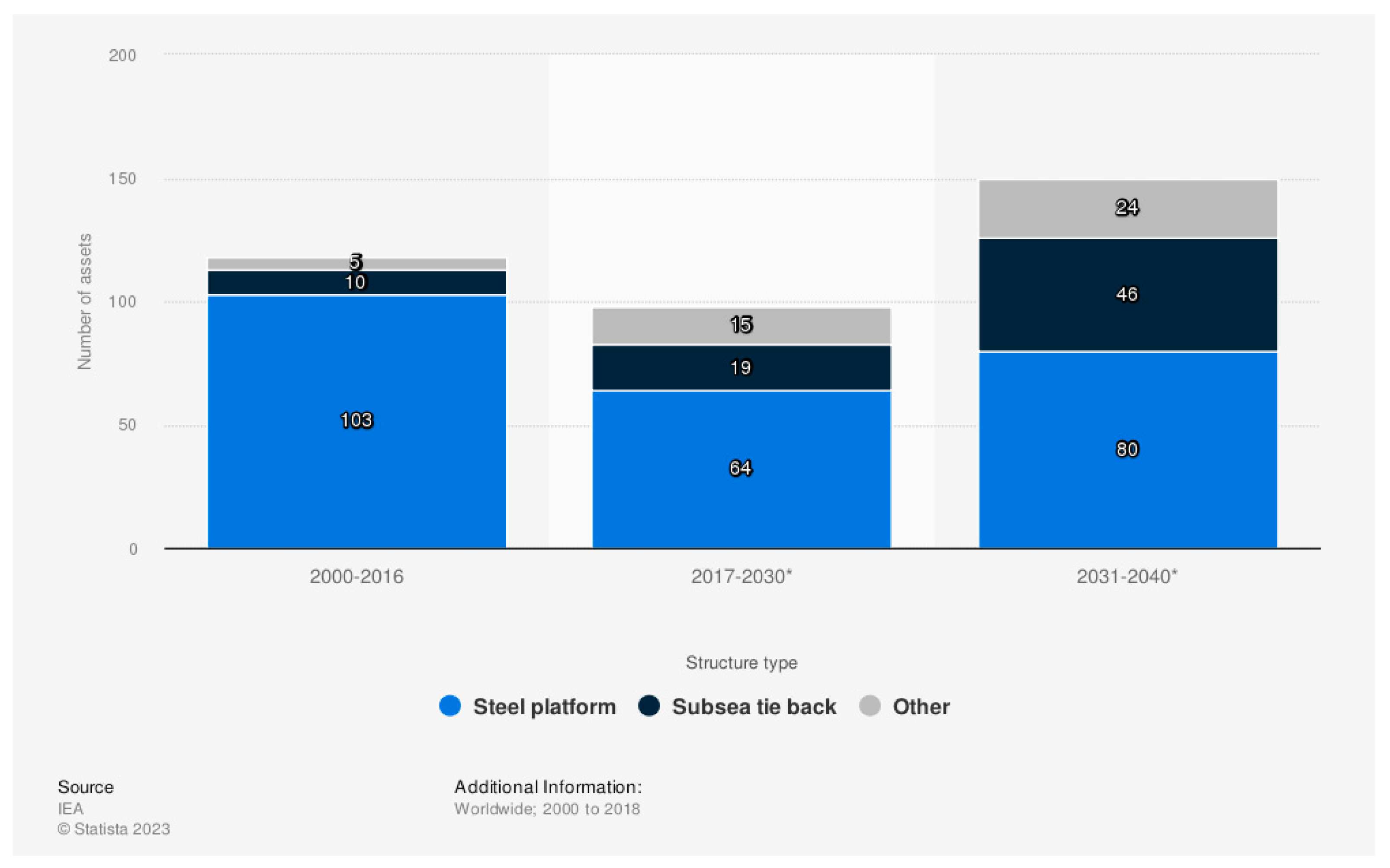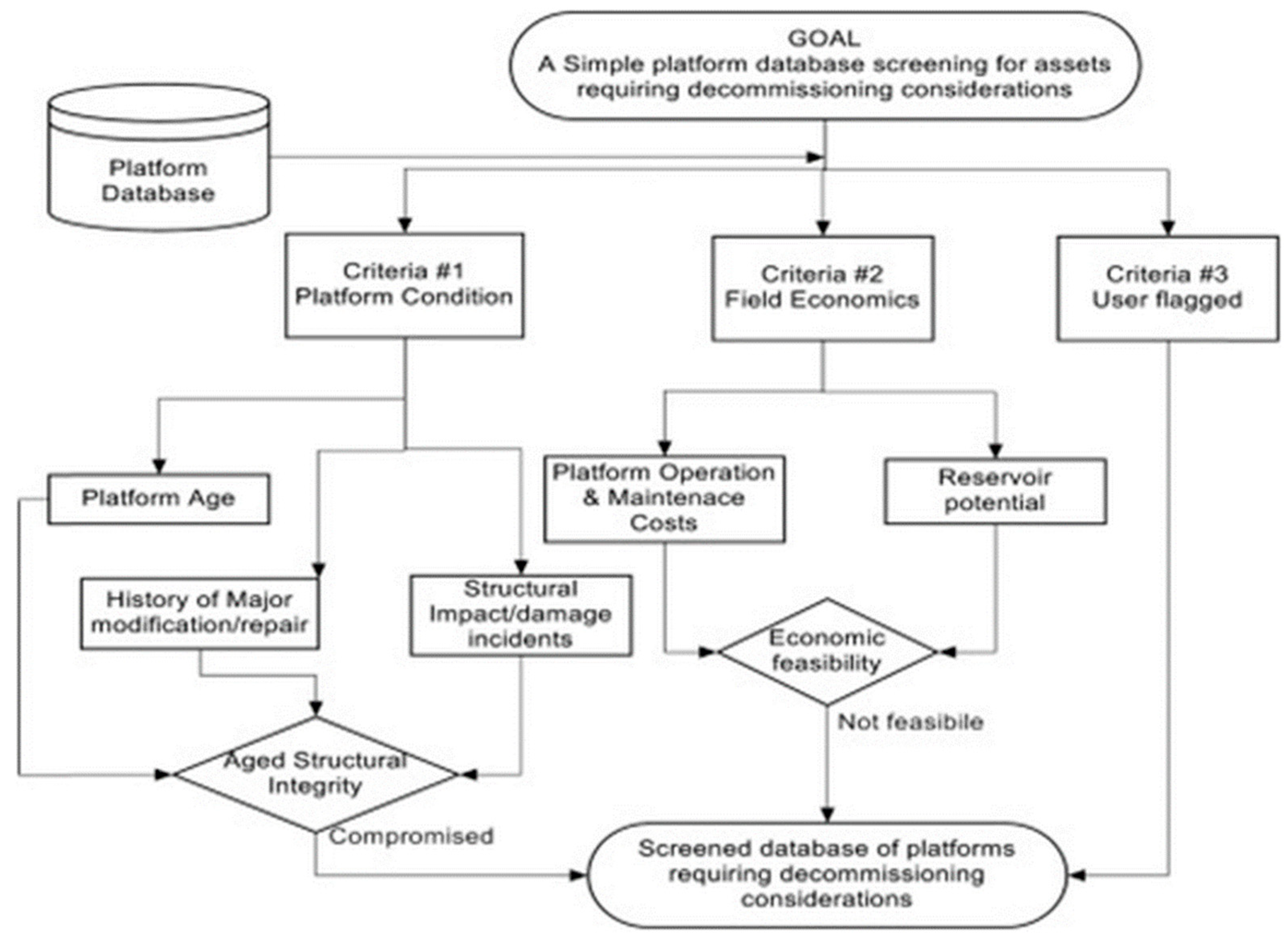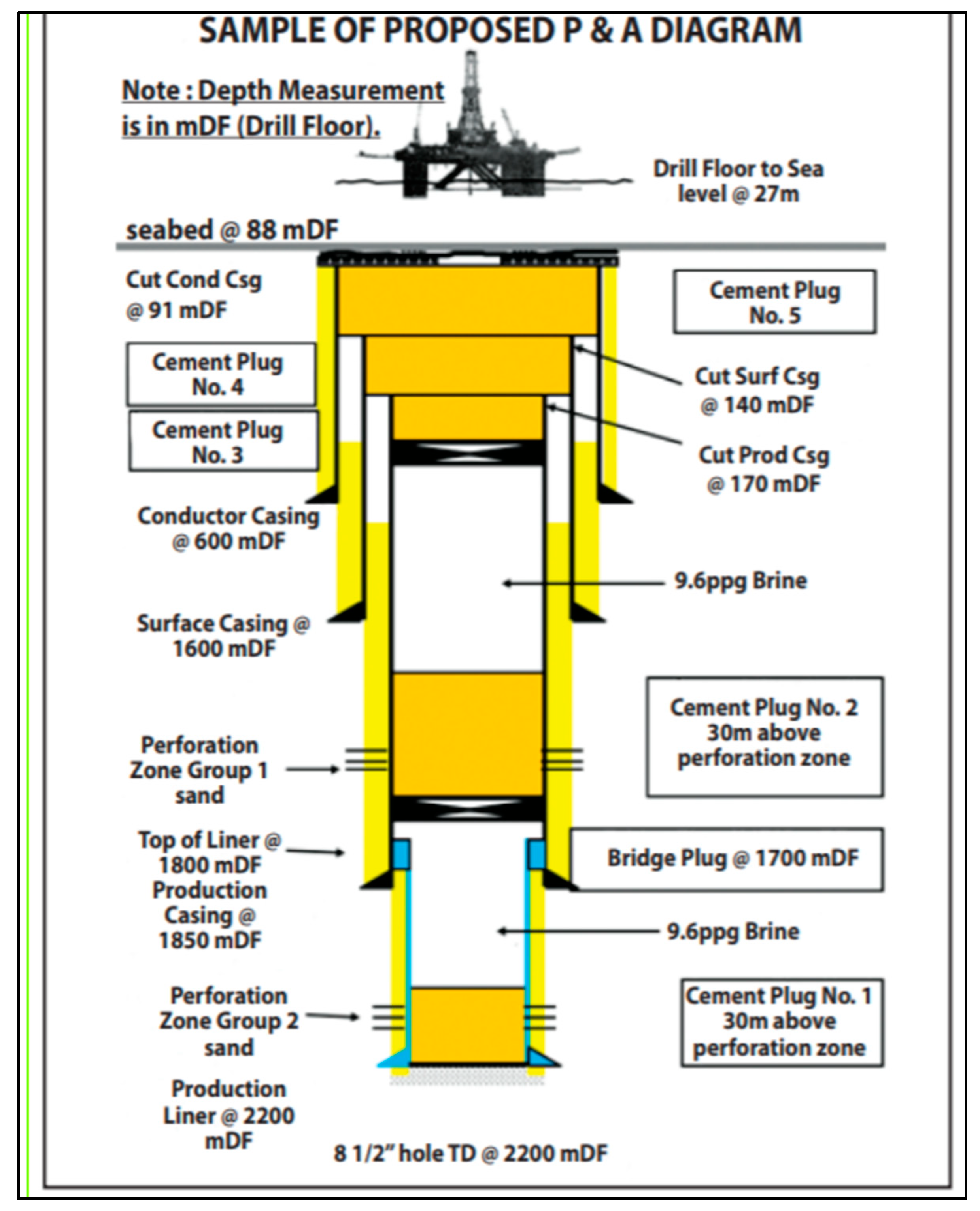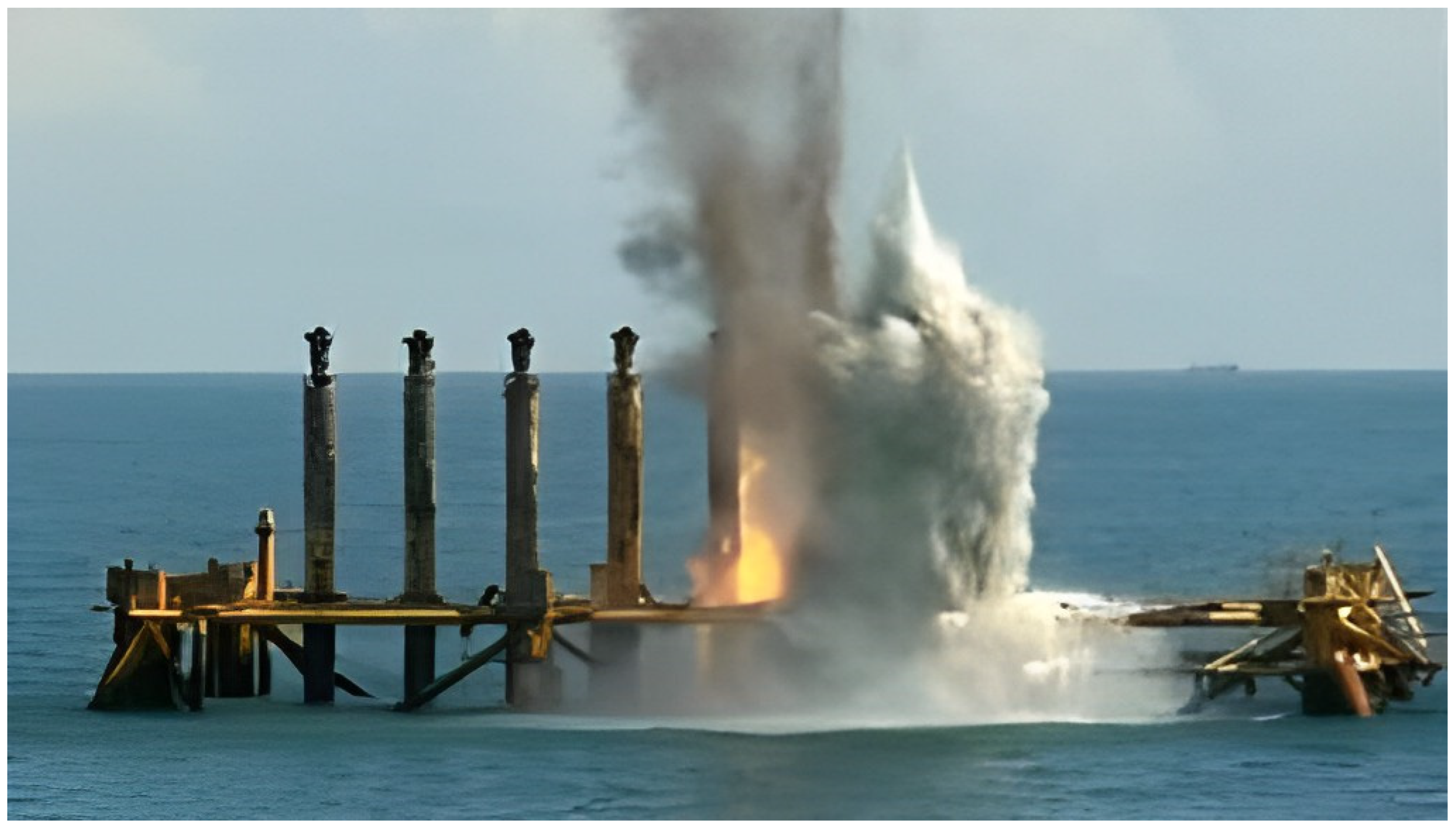Environmental Sustainability and Efficiency of Offshore Platform Decommissioning: A Review
Abstract
:1. Introduction
2. Review Methodology
3. Principles and History of Decommissioning
- Platforms that are composed of support structures and topsides;
- Floating vessels;
- Subsea equipment and supporting structures;
- Infield and export pipelines;
- Ancillary facilities (heavy concrete mattresses, rocks used for pipeline stability);
- Wells.
4. Systems for Decommissioning and Environmental Impact
- Lack of experience required for the removal of deep-water platforms;
- Poor infrastructure and an exorbitant cost of vessel mobilization;
- Inappropriate onshore processing materials and disposal options;
- A complex regulatory framework;
- Strong emphasis on the protection of marine life;
- Restrictive air emission requirements;
- Uncertain site clearance requirements for shell mounds.
4.1. Decommissioning Phases and Their Environmental Concerns
4.2. Removal Option
- Piece-small removal method (offshore demolition method);
- Piece-large removal method involving a heavy-lift vessel (HLV), cargo barges, and tugs;
- Piece-large removal technique via HLV with extended lift operations;
- Single-piece removal method using a single-lift vessel (SLV).
4.2.1. Complete Removal Option
4.2.2. Partial Removal Option
5. Environmental Sustainability of Using Vacuum-Sealed Pile in Offshore Platform Decommissioning
5.1. Extraction and Transfer Platforms
5.2. Explosive Removal of Offshore Structures
6. Future Perspectives
- Topside removal: There are several options for dismantling offshore platforms, some requiring fewer but heavier lifts and others requiring more but lighter lifts. Experience is required to determine which are the best to use, but this is unlikely to be a one-of-a-kind solution;
- Planning, time scale, and cost: Planning, schedule, and budget are essential factors to consider. These are the most important aspects of the procedure because if even one of them is not well organized, the costs could skyrocket. Due to the challenging environment in which the task must be completed, the weather must be carefully considered. The procedures should preferably be performed during the summer to avoid the winter. Two summers might be preferable;
- Optimization of available space: The deck areas of ships are limited. To achieve a resourceful mode of transportation, effective space design is required. The way the turbines, transition components, and foundations are fitted and secured once placed on the transportation vessel is an important factor that is often overlooked in decommissioning plans. The components can be welded to the deck or mounted on a prefabricated rack, depending on the vessel’s stability, weight, and space. They can also be placed vertically or horizontally, but their options are limited by the stability, weight, and available space of the vessel.
7. Conclusions
- Significantly reduces the decommissioning cost when compared with other cutting techniques;
- Enables control of the propagation of wave shocks;
- Enables understanding of the performance of low-pressure wave pulses;
- Establishes a low-threat technique for sea animals by controlling blast wave shocks (fish, turtles, dolphins, whales, etc.);
- There are no delays for the project due to protecting vessels and overflying traffic;
- Improves the safety of personnel (divers and crew on vessels).
Author Contributions
Funding
Institutional Review Board Statement
Informed Consent Statement
Data Availability Statement
Acknowledgments
Conflicts of Interest
Abbreviations
| BTC | Benefit to Cost |
| BPEO | Best Practical Environmental Option |
| CA | Comparative Evaluation |
| DP | Decommissioning Plan |
| GOM | Gulf of Mexico |
| PPGUA | Guidelines for Upstream Activities |
| HLV | Heavy-lift vessel |
| IA | Impact Assessment |
| IMO | International Maritime Organization |
| MCDA | Multi-criteria decision analysis |
| NPV | Net present value |
| SLV | Single-lift Vessel |
| PPGUA | Procedures and Guidelines for Upstream Activities |
| P&A | Plug and Abandonment |
| TNT | Trinitrotoluene |
| UNCLOS | United Nations Convention on the Law of the Sea |
| UKCS | United Kingdom Continental Shelf |
| US | United States |
| UK | United Kingdom |
| WBS | Work Breakdown Structure |
References
- Fam, M.L.; Konovessis, D.; Ong, L.S.; Tan, H.K. A review of offshore decommissioning regulations in five countries—Strengths and weaknesses. Ocean Eng. 2018, 160, 244–263. [Google Scholar] [CrossRef]
- Marcio de Almeida, D.A. Transportation, Energy Use and Environmental Impacts; Elsevier: Amsterdam, The Netherlands, 2019. [Google Scholar]
- Wright, E.; Mathews, R. Preliminary work for stage 2 decommissioning of B16 pile chimney. In Civil Engineering in the Nuclear Industry: Proceedings of the Conference Organized by the Institution of Civil Engineers and Held in Windermere on 20–22 March 1991; Thomas Telford Publishing: London, UK, 1991; pp. 347–360. [Google Scholar]
- Bureau of Safety and Environmental Enforcement. What Is Decommissioning of Offshore Platforms? Available online: https://www.bsee.gov/public-faqs/what-is-decommissioning-of-offshore-platforms (accessed on 3 February 2023).
- Zawawi, N.A.W.A.; Liew, M.S.; Na, K.L. Decommissioning of offshore platform: A sustainable framework. In Proceedings of the 2012 IEEE Colloquium on Humanities, Science and Engineering (CHUSER), Kota Kinabalu, Malaysia, 3–4 December 2012; pp. 26–31. [Google Scholar] [CrossRef]
- Wu, Z. Type of Suction Leg, an Offshore Caisson and a Sit-on-Bottom Offshore Platform. Google Patents 2018. Available online: https://patents.google.com/patent/US10060090B2/en (accessed on 3 February 2023).
- Liu, G.; Qiu, D. Decontamination and Decommissioned Small Nuclear AIP Hybrid Systems Submarines. TELKOMNIKA Indones. J. Electr. Eng. 2013, 11, 6855–6861. [Google Scholar] [CrossRef]
- Marine Board; National Research Council. An Assessment of Techniques for Removing Offshore Structures; National Academies: Washington, DC, USA, 1996. [Google Scholar] [CrossRef]
- Topham, E.; McMillan, D. Sustainable decommissioning of an offshore wind farm. Renew. Energy 2017, 102, 470–480. [Google Scholar] [CrossRef]
- Irawan, C.A.; Wall, G.; Jones, D. An optimisation model for scheduling the decommissioning of an offshore wind farm. OR Spectr. 2019, 41, 513–548. [Google Scholar] [CrossRef]
- Maslin, E. Oil & Gas-Decommissioning. Salvage, Sink or Save?[North Sea oil decommissioning]. Eng. Technol. 2020, 15, 60–63. [Google Scholar]
- DeMarsh, G. The Use of Explosives in Decommissioning and Salvage. In Proceedings of the Offshore Technology Conference, Houston, TX, USA, 1–4 May 2000. OTC-12023-MS. [Google Scholar] [CrossRef]
- Thornton, W.; Wiseman, J. Current trends and future technologies for the decommissioning of offshore platforms. In Proceedings of the Offshore Technology Conference, Houston, TX, USA, 1–4 May 2000. [Google Scholar]
- Bernstein, B.B. Decision framework for platform decommissioning in California. Integr. Environ. Assess. Manag. 2015, 11, 542–553. [Google Scholar] [CrossRef]
- Kaiser, M.J. Offshore decommissioning cost estimation in the Gulf of Mexico. J. Constr. Eng. Manag. 2006, 132, 249–258. [Google Scholar] [CrossRef]
- TEI Construction Services; DEMEX Division. Explosive Technology Report; 2000. Available online: https://www.bsee.gov/sites/bsee.gov/files/tap-technical-assessment-program/372aa.pdf (accessed on 10 December 2022).
- Bouffard, S.C.; West-Sells, P.G. Hydrodynamic behavior of heap leach piles: Influence of testing scale and material properties. Hydrometallurgy 2009, 98, 136–142. [Google Scholar] [CrossRef]
- Aizarani, J. Offshore Oil and Gas: Asset Decommissioning Requirement by Structure 2000–2040. Statista. Available online: https://www-statista-com.eu1.proxy.openathens.net/statistics/920989/offshore-oil-and-gas-asset-decommissioning-need-by-structure/ (accessed on 4 July 2023).
- National Marine Fisheries Service. Endangered Species Act Section 7 Consultation Biological Opinion. 2006. Available online: https://www.boem.gov/sites/default/files/environmental-stewardship/Environmental-Studies/Gulf-of-Mexico-Region/ESA_Biological_Opinion.pdf (accessed on 21 December 2022).
- Capobianco, N.; Basile, V.; Loia, F.; Vona, R. Toward a Sustainable Decommissioning of Offshore Platforms in the Oil and Gas Industry: A PESTLE Analysis. Sustainability 2021, 13, 6266. [Google Scholar] [CrossRef]
- Braga, J.; Santos, T.; Shadman, M.; Silva, C.; Assis Tavares, L.F.; Estefen, S. Converting Offshore Oil and Gas Infrastructures into Renewable Energy Generation Plants: An Economic and Technical Analysis of the Decommissioning Delay in the Brazilian Case. Sustainability 2022, 14, 13783. [Google Scholar] [CrossRef]
- Basack, S.; Goswami, G.; Dai, Z.-H.; Baruah, P. Failure-Mechanism and Design Techniques of Offshore Wind Turbine Pile Foundation: Review and Research Directions. Sustainability 2022, 14, 12666. [Google Scholar] [CrossRef]
- Chandler, J.; White, D.; Techera, E.J.; Gourvenec, S.; Draper, S. Engineering and legal considerations for decommissioning of offshore oil and gas infrastructure in Australia. Ocean Eng. 2017, 131, 338–347. [Google Scholar] [CrossRef]
- Hamzah, B.A. International rules on decommissioning of offshore installations: Some observations. Mar. Policy 2003, 27, 339–348. [Google Scholar] [CrossRef]
- Alghamdi, A.A.; Radwan, A.M. Decommissioning of offshore structures: Challenges and solutions. In Proceedings of the International Conference on Computational Methods in Marine Engineering (MARINE 2005), Barcelona, Spain, 2005; Bergan, J.G.P., Onate, E., Kvamsdal, T., Eds.; CIMNE: Barcelona, Spain, 2005. Available online: https://www.researchgate.net/publication/332539561 (accessed on 3 March 2023).
- Techera, E.J.; Chandler, J. Offshore installations, decommissioning and artificial reefs: Do current legal frameworks best serve the marine environment? Mar. Policy 2015, 59, 53–60. [Google Scholar] [CrossRef]
- Eke, E.; Iyalla, I.; Andrawus, J.; Prabhu, R. Optimising Offshore Structures Decommissioning—A Multicriteria Decision Approach. In Proceedings of the SPE Nigeria Annual International Conference and Exhibition, Virtual, 11–13 August 2020. D013S009R015. [Google Scholar] [CrossRef]
- OGUK. Decommissioning Insight 2020. 2020. Available online: https://oilandgasuk.co.uk/product/decommissioning-insight-report (accessed on 10 December 2022).
- Na, K.L.; Lee, H.E.; Liew, M.S.; Wan Abdullah Zawawi, N.A. An expert knowledge based decommissioning alternative selection system for fixed oil and gas assets in the South China Sea. Ocean Eng. 2017, 130, 645–658. [Google Scholar] [CrossRef]
- Ars, F.; Rios, R. Decommissioning: A Call for a New Approach. In Proceedings of the Offshore Technology Conference, Houston, TX, USA, 1–4 May 2017. D031S037R007. [Google Scholar] [CrossRef]
- Byrd, R.C.; Smith, J.B.; Spease, S.J. The Challenges Facing the Industry in Offshore Facility Decommissioning on the California Coast. In Proceedings of the Offshore Technology Conference, Houston, TX, USA, 30 April–3 May 2018. D032S092R013. [Google Scholar] [CrossRef]
- Department of Environment. Environmental Guidelines for Decommissioning of Oil and Gas Facilities in Malaysia; Ministry of Energy, Science, Technology, Environment & Climate Change (MESTECC): Putrajaya, Malaysia, 2019. [Google Scholar]
- PPGUA. PETRONAS Procedures and Guidelines for Upstream Activities (PPGUA). Available online: https://www.petronas.com/mpm/about-mpm/ppgua (accessed on 21 December 2022).
- BSEE. Decommissioning Cost Update for Pacific Outer Continental Shelf Region Facilities. In A Study for the Bureau of Safety and Environmental Enforcement; 2020; Volume 2. Available online: https://www.bsee.gov/sites/bsee.gov/files/vol-2-a-study-for-the-bureau-of-safety-and-environmental-enforcement-bsee-final-9-8-20.pdf (accessed on 21 December 2022).
- International Association of Oil & Gas Producers. Overview of International Offshore Decommissioning Regulations; 2017; Volume 2. Available online: https://www.extractiveshub.org/servefile/getFile/id/6667 (accessed on 3 March 2023).
- Adedipe, T.; Shafiee, M. An economic assessment framework for decommissioning of offshore wind farms using a cost breakdown structure. Int. J. Life Cycle Assess. 2021, 26, 344–370. [Google Scholar] [CrossRef]
- Andrawus, J.A.; Steel, J.A.; Watson, J.F. A Hybrid Approach To Assess Decommissioning Options for Offshore Installations. In Proceedings of the Nigeria Annual International Conference and Exhibition, Abuja, Nigeria, 3–5 August 2009. SPE-128599-MS. [Google Scholar] [CrossRef]
- Yakob, R. Well Plugging & Abandonment: Oil & Gas Asset Decommissioning. JURUTERA 2018. Available online: http://dspace.unimap.edu.my/bitstream/handle/123456789/62234/Well%20Plugging%20%26%20Abandonment%20Oil%20%26%20Gas%20Asset%20Decommissioning.pdf?sequence=1&isAllowed=y (accessed on 12 May 2022).
- Bull, A.S.; Love, M.S. Worldwide oil and gas platform decommissioning: A review of practices and reefing options. Ocean Coast. Manag. 2019, 168, 274–306. [Google Scholar] [CrossRef]
- Parente, V.; Ferreira, D.; dos Santos, E.M.; Luczynski, E. Offshore decommissioning issues: Deductibility and transferability. Energy Policy 2006, 34, 1992–2001. [Google Scholar] [CrossRef]
- Chan, H.-S.; Krachtoudi, C.; De Lorenzi Cavallari, L.; Carlile, G.C. Development of Topsides and Jacket Removal Programme for Miller Platform Decommissioning. In Proceedings of the Offshore Technology Conference, Houston, TX, USA, 4–7 May 2020. D031S031R001. [Google Scholar] [CrossRef]
- Claisse, J.T.; Pondella, D.J.; Love, M.; Zahn, L.A.; Williams, C.M.; Bull, A.S. Impacts from partial removal of decommissioned oil and gas platforms on fish biomass and production on the remaining platform structure and surrounding shell mounds. PLoS ONE 2015, 10, e0135812. [Google Scholar] [CrossRef] [PubMed]
- Lemasson, A.J.; Knights, A.M.; Thompson, M.; Lessin, G.; Beaumont, N.; Pascoe, C.; Queirós, A.M.; McNeill, L.; Schratzberger, M.; Somerfield, P.J. Evidence for the effects of decommissioning man-made structures on marine ecosystems globally: A systematic map protocol. Environ. Evid. 2021, 10, 4. [Google Scholar] [CrossRef]
- Murphy, C.; Higgins, S.A. Australia offshore well inventory characterisation and decommissioning cost saving opportunities through cap rock restoration and rigless/riserless techniques. APPEA J. 2021, 61, 445–449. [Google Scholar] [CrossRef]
- Fowler, A.M.; Jørgensen, A.M.; Svendsen, J.C.; Macreadie, P.I.; Jones, D.O.; Boon, A.R.; Booth, D.J.; Brabant, R.; Callahan, E.; Claisse, J.T. Environmental benefits of leaving offshore infrastructure in the ocean. Front. Ecol. Environ. 2018, 16, 571–578. [Google Scholar] [CrossRef]
- Ashley, M.; Mangi, S.; Rodwell, L. The potential of offshore windfarms to act as marine protected areas—A systematic review of current evidence. Mar. Policy 2014, 45, 301–309. [Google Scholar] [CrossRef]
- Topham, E.; Gonzalez, E.; McMillan, D.; João, E. Challenges of decommissioning offshore wind farms: Overview of the European experience. J. Phys. Conf. Ser. 2019, 1222, 012035. [Google Scholar] [CrossRef]
- Anthony, N.; Ronalds, B.; Fakas, E. Platform decommissioning trends. In Proceedings of the SPE Asia Pacific Oil and Gas Conference and Exhibition, Brisbane, Australia, 16–18 October 2000. [Google Scholar]
- Kaiser, M.J.; Pulsipher, A.G. Rigs-to-reef programs in the Gulf of Mexico. Ocean Dev. Int. Law 2005, 36, 119–134. [Google Scholar] [CrossRef]
- Kaiser, M.J.; Liu, M. Decommissioning cost estimation in the deepwater US Gulf of Mexico–Fixed platforms and compliant towers. Mar. Struct. 2014, 37, 1–32. [Google Scholar] [CrossRef]
- McDonald, I. Decommissioning—Challenge, Accepted! Westwood Analysis, 15 January 2018. Available online: https://www.westwoodenergy.com/news/westwood-insight-decommissioning-challenge-accepted(accessed on 3 March 2023).
- Sommer, B.; Fowler, A.M.; Macreadie, P.I.; Palandro, D.A.; Aziz, A.C.; Booth, D.J. Decommissioning of offshore oil and gas structures–Environmental opportunities and challenges. Sci. Total Environ. 2019, 658, 973–981. [Google Scholar] [CrossRef] [PubMed]
- Kaiser, M.J.; Pulsipher, A.G.; Byrd, R.C. Decommissioning cost functions in the Gulf of Mexico. J. Waterw. Port Coast. Ocean Eng. 2003, 129, 286–296. [Google Scholar] [CrossRef]
- Schroeder, D.M.; Love, M.S. Ecological and political issues surrounding decommissioning of offshore oil facilities in the Southern California Bight. Ocean Coast. Manag. 2004, 47, 21–48. [Google Scholar] [CrossRef]
- Conventional Sheet Piling—Sheet Piling (UK) Ltd. Available online: https://www.sheetpilinguk.com/sheet-piling-methods/conventional-sheet-piling/# (accessed on 28 June 2023).
- Ahuja, M.P.; McGufee, J.C.; Poulter, S.A. Decommissioning of Belmont Island, an Offshore Oil Platform. In Proceedings of the SPE Western Regional/AAPG Pacific Section Joint Meeting, Long Beach, CA, USA, 19–24 May 2003. [Google Scholar]
- Day, M.; Marks, M. 5 Decommissioning of offshore oil and gas. In Environmental Technology in the Oil Industry; Springer: Berlin/Heidelberg, Germany, 2013; p. 208. [Google Scholar]
- Urnes, M. Methods for Decommission of Offshore Wind Parks on the Basis of the Knowledge from the Oil- and Gas Industry; Høgskolen på Vestlandet: Bergen, Norway, 2019. [Google Scholar]
- Kim, M.; Kim, C.-L.; Shin, S. Development of NPP decommissioning cost estimation algorithm based on the CANDU structure. Ann. Nucl. Energy 2022, 166, 108728. [Google Scholar] [CrossRef]
- Salazar, M.; Elder, J. Decommissioning the UHTREX Reactor Facility at Los Alamos, New Mexico; Los Alamos National Lab.: Carlsbad, NM, USA, 1992. [Google Scholar]
- Kim, H.; Kim, H. General Approach and Element for Estimating Decommissioning Cost; 2014. Available online: https://www.kns.org/files/pre_paper/31/31%EA%B9%80%ED%95%99%EC%88%98.pdf (accessed on 21 December 2022).
- Davidova, I.; Desecures, S.; Lexow, T.; Buonarroti, S.; Marini, G.; Pescatore, C.; Rehak, I.; Weber, I.; Daniska, V.; Linan, J.B. The Practice of Cost Estimation for Decommissioning of Nuclear Facilities; Organisation for Economic Co-Operation and Development: Paris, France, 2015. [Google Scholar]
- Park, H.S.; Park, S.K.; Park, K.N.; Choi, J.W.; Nam, J.S.; Hong, Y.J. Development of Decommissioning Information Integrated Management System; Korea Atomic Energy Research Institute: Daejeon, Republic of Korea, 2018. [Google Scholar]
- Park, H.S.; Hong, Y.J.; Kim, J.G.; Choi, J.W. Implementation of connectivity between facility characterization and decommissioning activity for dismantling of nuclear facilities. Fuel 2018, 132, 87. [Google Scholar]
- Brusa, L.; DeSantis, R.; Nurden, P.; Walkden, P.; Watson, B. The Decommissioning of the Trino Nuclear Power Plant; Sogin: Rome, Italy; ND& CU BNFL: London, UK; BNFL Inc.: Washington, DC, USA, 2002. [Google Scholar]
- Johnson, M.W.; Christensen, C.M.; Kagermann, H. Reinventing your business model. Harv. Bus. Rev. 2008, 86, 57–68. [Google Scholar]
- Meglio, O.; Park, K. Strategic Decisions and Sustainability Choices: Mergers, Acquisitions and Corporate Social Responsibility from a Global Perspective; Springer: Berlin/Heidelberg, Germany, 2019. [Google Scholar]
- Cardoni, A.; Kiseleva, E.; Terzani, S. Evaluating the intra-industry comparability of sustainability reports: The Case of the oil and gas industry. Sustainability 2019, 11, 1093. [Google Scholar] [CrossRef]
- Schneider, J.; Ghettas, S.; Merdaci, N.; Brown, M.; Martyniuk, J.; Alshehri, W.; Trojan, A. Towards sustainability in the oil and gas sector: Benchmarking of environmental, health, and safety efforts. J. Environ. Sustain. 2013, 3, 6. [Google Scholar]
- Silvestre, B.S.; Gimenes, F.A.P. A sustainability paradox? Sustainable operations in the offshore oil and gas industry: The case of Petrobras. J. Clean. Prod. 2017, 142, 360–370. [Google Scholar] [CrossRef]
- Barata, J.F.F.; Quelhas, O.L.G.; Costa, H.G.; Gutierrez, R.H.; de Jesus Lameira, V.; Meiriño, M.J. Multi-criteria indicator for sustainability rating in suppliers of the oil and gas industries in Brazil. Sustainability 2014, 6, 1107–1128. [Google Scholar] [CrossRef]
- Maes, J.; Hauck, J.; Paracchini, M.L.; Ratamäki, O.; Hutchins, M.; Termansen, M.; Furman, E.; Perez-Soba, M.; Braat, L.; Bidoglio, G. Mainstreaming ecosystem services into EU policy. Curr. Opin. Environ. Sustain. 2013, 5, 128–134. [Google Scholar] [CrossRef]
- Viada, S.T.; Hammer, R.M.; Racca, R.; Hannay, D.; Thompson, M.J.; Balcom, B.J.; Phillips, N.W. Review of potential impacts to sea turtles from underwater explosive removal of offshore structures. Environ. Impact Assess. Rev. 2008, 28, 267–285. [Google Scholar] [CrossRef]
- Day, M.; Gusmitta, A. Decommissioning of offshore oil and gas installations. In Environmental Technology in the Oil Industry; Springer: Berlin/Heidelberg, Germany, 2016; pp. 257–283. [Google Scholar]
- Snell, J. Kill Zone: Cleaning up Oil Junk, Killing Tens of Thousands of Fish. 2013. Available online: https://www.fox8live.com/story/21347595/program-to-clean-up-offshore-oil-junk-kills-tens-of-thousands-of-fish/ (accessed on 10 December 2022).
- Piper Alpha Platform, North Sea. 2013. Available online: https://www.offshore-technology.com/projects/piper-alpha-platform-north-sea/ (accessed on 11 January 2022).
- Kaiser, M.J.; Pulsipher, A.G. A binary choice severance selection model for the removal of offshore structures in the Gulf of Mexico. Mar. Policy 2004, 28, 97–115. [Google Scholar] [CrossRef]
- Kaiser, M.J.; Byrd, R.C. The non-explosive removal market in the Gulf of Mexico. Ocean Coast. Manag. 2005, 48, 525–570. [Google Scholar] [CrossRef]
- Kaiser, M.J.; Mesyanzhinov, D.V.; Pulsipher, A.G. Explosive removals of offshore structures in the Gulf of Mexico. Ocean Coast. Manag. 2002, 45, 459–483. [Google Scholar] [CrossRef]
- Gell, F.; Roberts, C. The fishery effects of marine reserves and fishery closures. Endangered Seas Campaign. In World Wildlife Fund Report; Washington, DC, USA, 2002; Available online: http://agris.fao.org/agris-search/search.do?recordID=GB2013202206 (accessed on 1 March 2023).
- Pacini, A.F.; Nachtigall, P.E.; Smith, A.B.; Suarez, L.J.A.; Magno, C.; Laule, G.E.; Aragones, L.V.; Braun, R. Evidence of hearing loss due to dynamite fishing in two species of odontocetes. Proc. Meet. Acoust. 2016, 27, 010043. [Google Scholar] [CrossRef]
- Poulsen, T.; Hasager, C.B. The (R) evolution of China: Offshore wind diffusion. Energies 2017, 10, 2153. [Google Scholar] [CrossRef]
- McMillan, D.; Dinwoodie, I.A. Forecasting long term jack up vessel demand for offshore wind. In Proceedings of the European Safety and Reliability (ESREL 2013) Conference, Amsterdam, The Netherlands, 29 September–2 October 2013. [Google Scholar]





| Item | Minimum Requirements | Legislation Driving Requirement |
|---|---|---|
| Do P&A activities need to be planned in advance? | Yes | PETRONAS Guideline |
| Barrier Type (Material) | As permanent barriers, solidified cement or mechanical plugs in conjunction with cement are appropriate. Permanent barriers are impermeable and nonshrinking barriers or combinations of barriers that create a seal with permanent or eternal qualities. | PETRONAS Guideline |
| Verification | You may perform a weight or tag test by attaching a minimum pipe weight of 10,000 pounds to the plug. During a 15 min period, pressure tests the casing against the plug with no more than a 10% pressure loss. | PETRONAS Guideline |
| Plugging Reservoir Requirements | A balanced cement plug should be installed opposite all open holes, reaching at least 30 m above and 30 m below the perforated interval or down to the casing plug, whichever would be the least. | PETRONAS Guideline |
| Intermediate Zone | Cement plugs must be placed 30 m below the bottom and 30 m above the top of all hydrocarbon zones and freshwater zones that are less than 300 m below the surface. This will keep any hydrocarbon-bearing zones apart from each other and from water-bearing formations, and it will keep fluids from moving to the surface. | PETRONAS Guideline |
| Surface | A cement plug at least 45 m long, with a top 45 m or less below sea level, must be installed in the smallest string of casing that reaches the sea floor. | PETRONAS Guideline |
| Annular Barrier Requirements | Any annular area that connects to an open hole and extends to the sea floor must be filled with cement. | PETRONAS Guideline |
| Casing Stump Requirement | A stub that terminates below a conductor casing must be filled by installing a cement plug 30 m below the stub. | PETRONAS Guideline |
| Control Line and Cabling | No Guidance | |
| Seabed | All casing, wellhead equipment, and pilling shells must be removed as far below the sea bottom as reasonably practicable (minimum of 1 m). | PETRONAS Guideline |
| Post-Abandonment Monitoring | No Guidance |
Disclaimer/Publisher’s Note: The statements, opinions and data contained in all publications are solely those of the individual author(s) and contributor(s) and not of MDPI and/or the editor(s). MDPI and/or the editor(s) disclaim responsibility for any injury to people or property resulting from any ideas, methods, instructions or products referred to in the content. |
© 2023 by the authors. Licensee MDPI, Basel, Switzerland. This article is an open access article distributed under the terms and conditions of the Creative Commons Attribution (CC BY) license (https://creativecommons.org/licenses/by/4.0/).
Share and Cite
Zawawi, N.A.W.A.; Danyaro, K.U.; Liew, M.S.; Shawn, L.E. Environmental Sustainability and Efficiency of Offshore Platform Decommissioning: A Review. Sustainability 2023, 15, 12757. https://doi.org/10.3390/su151712757
Zawawi NAWA, Danyaro KU, Liew MS, Shawn LE. Environmental Sustainability and Efficiency of Offshore Platform Decommissioning: A Review. Sustainability. 2023; 15(17):12757. https://doi.org/10.3390/su151712757
Chicago/Turabian StyleZawawi, Noor Amila Wan Abdullah, Kamaluddeen Usman Danyaro, M. S. Liew, and Lim Eu Shawn. 2023. "Environmental Sustainability and Efficiency of Offshore Platform Decommissioning: A Review" Sustainability 15, no. 17: 12757. https://doi.org/10.3390/su151712757
APA StyleZawawi, N. A. W. A., Danyaro, K. U., Liew, M. S., & Shawn, L. E. (2023). Environmental Sustainability and Efficiency of Offshore Platform Decommissioning: A Review. Sustainability, 15(17), 12757. https://doi.org/10.3390/su151712757







